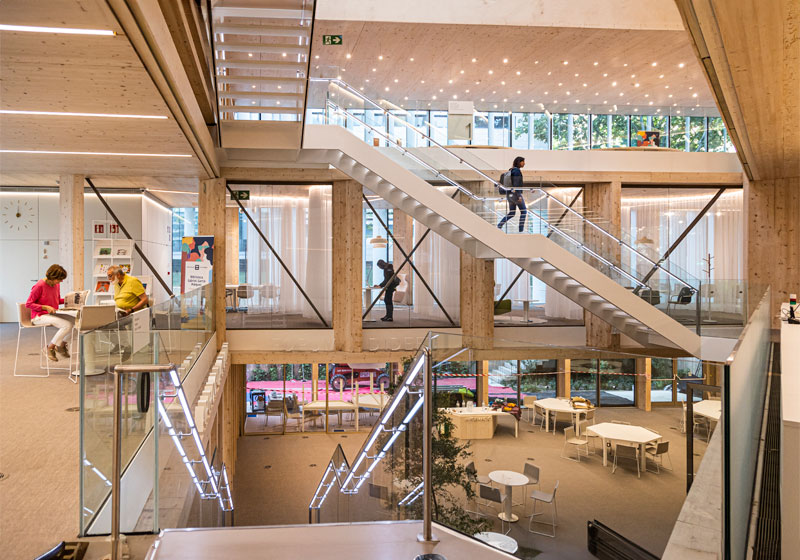Table of Contents
Public libraries are no longer just temples of knowledge. In addition to fostering reading habits, stimulating imagination and creativity, and facilitating access to cultural ideas, they are also places in which people can meet and exchange experiences. This is what is known as a “third place”, a term coined by Ray Oldenburg in his book “The Great Good Place” (1999). The American sociologist was referring to places where formal or informal learning takes place. The home and the workplace were the first and second place, respectively. And then there were those hybrid spaces which we perceive as welcoming, such as libraries, cafés, parks or gyms.
This definition includes, unquestionably, the Gabriel García Márquez Library, in the Sant Martí neighbourhood of Barcelona, the best public library in the world of 2023 according to the International Federation of Library Associations and Institutions (IFLA).

Structure in the form of open books
Inaugurated in May 2022, the facility spans 4,294 m2 over five floors, with a triangular central courtyard that connects them all through a staircase and brings natural light to the heart of the building. The structure is a combination of wood – from FSC-certified forests – and steel, which not only reduces the carbon footprint and lowers production costs, but also serves an aesthetic purpose. The building itself resembles a stack of books open to white pages, facing different directions.

Spaces that adapt to the user
Suma Studios, the architects of this project, have not only strived to achieve the highest architectural standards, but also considered the utility of each space down to the last millimetre. In the Gabriel García Márquez Library, each user can find their own special spot.

There are areas enclosed by sheer white curtains that wouldn’t be out of place in the most modern co-working spaces. An outdoor patio surrounded by trees and plants, where you can listen to the birds while working on your laptop. An indoor space with hammocks to make yourself comfortable while leafing through a book. A kitchen with scheduled talks with health workers to promote healthy lifestyle habits. An auditorium, multimedia room, a room for book clubs and an environment specially designed for sensory stimulation.

The Barcelona library is the only library in Spain with its own radio station. On Ràdio Maconda there is space for neighbourhood and educational organisations and associations who want to showcase their activity, with programmes later uploaded online in the form of podcasts. There are already almost 100!

Tribute to the Nobel Prize and Latin American Literature
The library pays tribute to the journalist and writer – whose figure is represented in a bronze bust – and, naturally, it specialises in Latin American literature. Interestingly, it is located right next to the Plaza Carme Balcells, agent of the Nobel Prize-winning author of “One Hundred Years of Solitude” and “No One Writes to the Colonel”, but also of other literary pioneers such as Mario Vargas Llosa, Julio Cortázar, Isabel Allende or Pablo Neruda.

The centre also houses the Francisco Ibáñez collection, one of Spain’s most prolific and renowned cartoonists, creator of characters such as Mortadelo and Filemón and the series Rue del Percebe and Sacarino the Bellhop. Ibáñez was a resident of the neighbourhood, which is why his collection is housed here. It is also the reason why a pedestrian traffic light featuring the iconic silhouettes of Mortadelo and Filemón was installed right in front of the library.
The library, the soul of the community
The Gabriel García Márquez Library, which serves 55,000 people and receives visitors from all over Barcelona and curious foreign tourists, was a historic claim of the neighbourhood. This is why, according to its librarians, the residents, young and old alike, have welcomed it with such enthusiasm. Young people gather by the entrance, which forms a kind of internal plaza, during morning break and also when they leave school in the afternoon. Older residents gather in the newspaper and magazine section to catch up. Kids can lie on the floor or sit on beanbag chairs in the children’s area.

This is just one small demonstration of how public libraries can become living spaces and the soul of an entire community.

